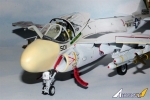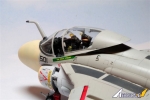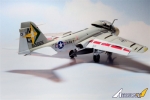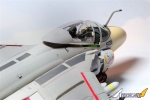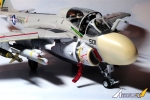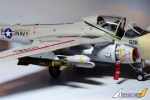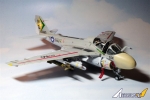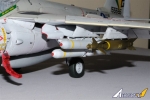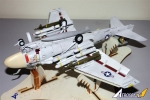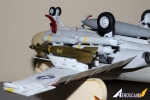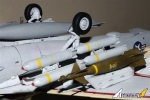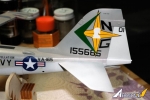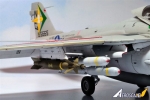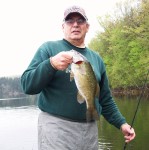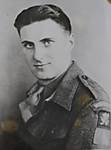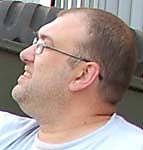1⁄48Grumman A-6E
15
Comments
History
The Grumman A-6 Intruder aircraft was designed as an all weather Attack aircraft for the Navy and Marine Corps, as the replacement for the Douglas A-1 Skyraider from 1963 to 1997.The Intruder received the new standardised system designation of A-6A in the Autumn of 1962, and entered squadron service in February 1963. The A-6 became both the U.S. Navy's and U.S. Marine Corps's main medium and Night/All Weather attack aircraft from the mid-1960s through the 1990s. A-6 Intruders first saw action during the Vietnam War, where they were used extensively against ground targets. The aircraft's long range and heavy payload of up to 18,000 pounds, coupled with its ability to fly in all weather made it invaluable during the war. The Intruder's large blunt nose and slender tail inspired a number of nicknames, including "Double Ugly", "The Mighty Alpha Six", "Iron Tadpole" and "Drumstick".
The A-6E version was the definitive attack version of the Intruder, which had upgraded navigation and attack systems that were 1st introduced in 1970, and deployed in December 1971. The last operation sortie by VA-34 was flown off the flight deck of the USS George Washington in 1996
By 1979 all A-6Es were upgraded to the TRAM system, which used a small stabilized turret under the nose of the aircraft.
The A-6E was the last variant before being retired. Both the F & G variants were cancelled.
The A-6 Intruder could and did carry every Missile and Bomb (including Nuclear weapons) in the Navyís arsenal.
The Kit
Hobby Boss had previously released a 1/48 scale A-6A Intruder, which was basically a scaled down version of the Trumpeter 1/32 A-6A. The A-6E was just released, which is basically the A version with the updated parts.I found the cockpit to be detailed well enough not to need a AM replacement, but did feel that the Quickboost GRU-7 ejection seats were a needed upgrade.
The kit contains the following options:
- 1. Detailed and positional canopy which I left semi opened for a more candid appearance.
- 2. Open or closed port and starboard boarding steps which are built up with some excellent PE parts.
- 3. A choice of a opened or closed Radome with a semi detailed radar detail. I opted to keep it closed.
- 4. Positionable tail hook which I left in the up position. There really isnít any reason to have it in the down position.
- 5. Positionable wingtip speed brakes which I also opted for the closed position
- 6. Positionable rudder that I stationed in the neutral position for no other reason then to aid in decal positioning.
- 7. Positionable ailerons
- 8. Positionable flaps, slats, in the down configuration, and the flaperons in the closed position as theyíre main function are as speed brakes.
- 9. Wings can be positioned folded or extended. I went with them extended for a different look than the norm.
The decal sheet has markings for two aircraft, and a fairly complete set of stencilling. I opted for a more colourful version and went with the Fightertown decals sheet #1 for Colourful A-6A/Es.
As I already stated, I opted to close the nose Radome as I wanted the look of A-6E ready for an operational sortie. Instead of the radar I added a 1 ounce fishing weight to make sure that it seats on its gear, and not its tail.
The fuselage is comprised of both right and left halves, and several sections. Once glued up I found most panels were close, but just about all needed some putty and sanding work. The end results were more than satisfactory.
The Slats, Flaps, were dropped into the down position, while the Flaperons were left in the closed position as they would be on the carrier deck. The landing gear was detailed with various brake and Hydraulic lines made from stretched sprue and copper wire.
Painting
The A-6E was painted with Tamiya Acrylic paints. I primed the entire aircraft with Tamiya Gray Lacquer primer, then lightly polished it with 8,000 & 12,000 micro mesh pads. I airbrushed the entire aircraft with Tamiya acrylic paints.White: XF-2 flat White
Light Gull Gray: XF-20 medium Gray & XF-2 white
The only exception was for the Tan Radome. There I used Mr. Color #318 Radome color, which is lacquer based paint. Thinned with Tamiya Yellow cap Lacquer Thinner I still had some tip clogging issues. Next time I used Mr. Color paints, Iíll be using their levelling Thinner which has a retarder in it.
I prefer NATO Black XF-69 over XF-1 flat black as it has a more pleasing scale effect.
Decals were by Fightertown. All stencilling was done with the kit decals. Decals were applied using the tried and true Microscale Method of Set and Sol.
Build log
For those of you that would like to read through the entire build blog located in the Cold War forum, it may be found here .Conclusion
The Hobby Boss kit does require a lot of work as there are fit issues, but none that canít be corrected. Overall, the build took me 3 Ĺ months to complete. The A-6E now seats proudly next to my F-4B. Would I build another one? Yes. Iím looking forward to eventually building both the A-6A and the A-6E TRAM versions.Comments
Jorl, super Intruder! I can imagine how good it looks next to the F-4B.
OCT 19, 2014 - 03:28 AM
Joel
What I meant was a full blow by blow article covering from start to finish, that way the images will always be accessable along with the information you have provided.
OCT 19, 2014 - 03:40 AM
Hi Joel
Great build! All Darren's saying is that the photos in your blog aren't future-proofed the way they would be if they were uploaded as "content" photos for Aeroscale.
All the best
Rowan
OCT 19, 2014 - 05:29 AM
Hi Kevin
Thanks for the comment about "flaperons" (or lack thereof..) . I found this on Joe Baugher's website that explains things further:
"The wing had trailing-edge flaps that extended over almost the entire length of the wing, so conventional ailerons were not fitted. Lateral controls was provided at low speeds by the movements of the flaps (operating as "flaperons") and at high speeds by a series of spoilers mounted on the upper wing surface. The spoilers could be operated differentially for roll control in flight."
All the best
Rowan
OCT 19, 2014 - 06:53 AM
A very impressive A6 Joel, very nicely done. An excellent paint job and the decals look super. Again very nicely done.
OCT 19, 2014 - 01:40 PM
What a magnificent build Joel. Really top notch build of another "Iron Works" aircraft.
OCT 20, 2014 - 06:01 AM
Great work on the A-6. Always loved that airplane.
I don't think it could carry the Aim-54 Phoenix? It's only launch platform was the F-14 Tomcat. Am I wrong, just curiosity.
Marc/ubi
OCT 23, 2014 - 12:42 PM
I don't think that it was Sparrow capable either. I think that Joel had in mind ground attack missiles such as Shrikes, Standards, Bullpups and the like.
The Intruder dug holes in the ground. The only times it distributed airplane parts was when they were on the ground.
OCT 23, 2014 - 03:13 PM
To further clarify my statement, here's the full weapons load available for the A-6E with various electronic upgrades:
Rockets:
2.75 in (70 mm) FFAR Rocket Pod
5 in (127 mm) Zuni Rocket Pod
Missiles:
AIM-9 Sidewinder air-to-air missile
AGM-45 Shrike anti-radiation missile
AGM-62 Walleye TV-guided glide bomb
AGM-65 Maverick air-to-ground missile
AGM-84 Harpoon air-to-ground missile
AGM-88 HARM anti-radiation missile
Bombs:
Mk 81 250 lb (113 kg) GP bombs
Mk 82 500 lb (227 kg) GP bombs
Mk 83 1,000 lb (454 kg) GP bombs
Mk 84 2,000 lb (907 kg) GP bombs
Mk 117 750 lb (340 kg) GP bombs
Mk-20 Rockeye II cluster bombs
CBU-89 GATOR mine cluster bombs
Mk 77 750 lb (340 kg) incendiary bombs
GBU-10 Paveway II laser-guided bombs
GBU-12 Paveway II laser-guided bombs
GBU-16 Paveway II laser-guided bombs
B43 nuclear bomb
B57 nuclear bomb
B61 nuclear bomb
B83 nuclear bomb
Various air-dropped landmines
Various air-dropped underwater mines
Various practice bombs [Mk-76, BDU-45, LGTR, etc.]
Joel
OCT 24, 2014 - 07:22 AM
Copyright ©2021 by Joel Willstein. Images also by copyright holder unless otherwise noted. The views and opinions expressed herein are solely the views and opinions of the authors and/or contributors to this Web site and do not necessarily represent the views and/or opinions of AeroScale, KitMaker Network, or Silver Star Enterrpises. Images also by copyright holder unless otherwise noted. Opinions expressed are those of the author(s) and not necessarily those of AeroScale. All rights reserved. Originally published on: 2014-10-18 06:15:55. Unique Reads: 9530






